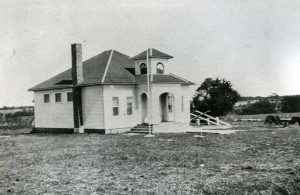In the Ottawa Herald of 2 Jan 1929, it reports that the school was burnt.
From “The hitching post…” column in the Ottawa Herald, a series of articles about early Franklin County schools researched by Bruce Fleming and written by Herald Editor and Publisher Jim Hitch. No date listed.
South Illinois School, District 72, was located five miles south and a half mile west of Pomona, on the north side of the road.
The school was organized in 1870 and closed in the spring of 1956.
The first school building was destroyed by fire on New Year’s Day, 1929. A new school—the last one to serve the district –was built that same year.
Amanda Cain was the teacher when South Illinois closed. Her students that year were Gerald Shepherd, Gary Stansbury, Bill Linden, David Hart, Carol Cade and Sandra Allen. Members of the last school board were Frank Stansbury, Mrs. L.J. Shepherd and C.L. Cox.
Other teachers who served the district included Elouise Davis, Edna Mae Anderson, Ray Thompson, William Chester, Irene Herron, Elnor (Darnell) Cannady, Ellen Blair, Lois Underwood, Eula Blankenbecker, Fay (Hoopes) Page, Leona (Smith) Wren, Wenona Shannon, Opal Davis, Esther Walter, Genevieve McDonald, Doris (Smith) Gentry, Elmia Stewart and Marguerite Reed.
Former South Illinois students still living in Franklin County include Ralph Allen, Betty (Allen) Bowman, Mabel (Everman) Justice, Donna (Duvall) Sauer, Elston Decker, Bayne (Scott) Hull, Virginia (Bush) Underwood, Marilyn (Bush) Underwood, Glen and Charles Underwood, Roger Bush, Marjory (Chambers) Kitts, Jean (Chambers) Clark, Kay (Chambers) Massengale, Virgil Chambers, Warren Lee Chambers, Gayle Chambers and Gerald Shepherd.
According to Ralph Allen, Pomona,”The original school site was taken from my grandfather’s (Samuel Allen’s) farm. I grew up there and went to school at South Illinois for eight years.”
Recalling the day of the fire, he said , “When the fire was discovered, Mary Eichman, the teacher, told everyone to get their coats and belongings from the cloak room and books from their desks and line up beside their desks. Then we marched out in single file, as we normally did at the end of each day.
“We kids thought sure that we would get out of going to school, but we didn’t miss a day. The following day we started to school at Central Church, located a half mile to the east, and continued there until the new schoolhouse was finished.”
Grace (Price) Hoobing, 212 S. Locust, also is a former student. “In March, 1921, five of us Price children started to school at South Illinois, after attending a two-room school at Michigan Valley. This was the last year that South Illinois had a seven-month school term.
“In those days, seventh, eighth and ninth graders were required to take state tests, so my father drove us in a buggy one rainy day to Greenwood, where we took our exams. He waited on us all day, until we were through.
“Several students were 17 and 18 years old that first year and the teacher was young and had very little control. Fortunately the older students didn’t return the following year.
“The old stove sat in the middle of the room and would be red-hot sometimes. Your face would be burning, but your back and feet would be cold. We wore our overshoes all day to keep warm. Children also wore ‘union suits’ We called them long underwear. We hated them, but Mom persisted.
Some kids were sewed into them for the winter. Those were ‘the good old days’ in most ways, but not always easy. Most schools were like one big happy family. We learned the basics well and had fun in the process. As a teacher of 36 years, I receive great joy meeting and visiting with students I had in school 50 and 60 years ago.”
From the superintendent of schools report of May 6, 1869: Spent P.M. exploring territory southeast of District 9 (Middletown). New settlement of 30 farmers from Illinois. (These families, no doubt, were the beginning of South Illinois, District 72, and North Illinois, District 59.)
Bob Duvall razed the school house and his son, Bud, and his wife, Linda, now live in a home on that site.

